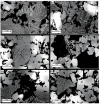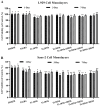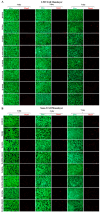Assessing Microstructural, Biomechanical, and Biocompatible Properties of TiNb Alloys for Potential Use as Load-Bearing Implants
- PMID: 39330229
- PMCID: PMC11432999
- DOI: 10.3390/jfb15090253
Assessing Microstructural, Biomechanical, and Biocompatible Properties of TiNb Alloys for Potential Use as Load-Bearing Implants
Abstract
Titanium-Niobium (TiNb) alloys are commonly employed in a number of implantable devices, yet concerns exist regarding their use in implantology owing to the biomechanical mismatch between the implant and the host tissue. Therefore, to balance the mechanical performance of the load-bearing implant with bone, TiNb alloys with differing porosities were fabricated by powder metallurgy combined with spacer material. Microstructures and phase constituents were characterized with energy dispersive spectroscopy (EDS), scanning electron microscopy (SEM), and X-ray diffraction (XRD). The mechanical properties were tested by uniaxial compression, and the corrosion performance was determined via a potentiodynamic polarization experiment. To evaluate a highly matched potential implant with the host, biocompatibilities such as cell viability and proliferation rate, fibronectin adsorption, plasmid-DNA interaction, and an SEM micrograph showing the cell morphology were examined in detail. The results showed that the alloys displayed open and closed pores with a uniform pore size and distribution, which allowed for cell adherence and other cellular activities. The alloys with low porosity displayed compressive strength between 618 MPa and 1295 MPa, while the alloys with high porosity showed significantly lower strength, ranging from 48 MPa to 331 MPa. The biological evaluation of the alloys demonstrated good cell attachment and proliferation rates.
Keywords: corrosion performance; cytocompatibility; load-bearing implant; powder metallurgy; spacer material.
Conflict of interest statement
The authors declare no conflict of interest.
Figures












Similar articles
-
Microstructural, Biomechanical, and In Vitro Studies of Ti-Nb-Zr Alloys Fabricated by Powder Metallurgy.Materials (Basel). 2023 Jun 8;16(12):4240. doi: 10.3390/ma16124240. Materials (Basel). 2023. PMID: 37374426 Free PMC article.
-
Microstructures, mechanical and corrosion properties of graphene nanoplatelet-reinforced zinc matrix composites for implant applications.Acta Biomater. 2023 Feb;157:701-719. doi: 10.1016/j.actbio.2022.11.060. Epub 2022 Dec 5. Acta Biomater. 2023. PMID: 36476647
-
Development of Ti-10Nb alloy by powder metallurgy processing route for dental application.J Biomed Mater Res B Appl Biomater. 2024 Jan;112(1):e35338. doi: 10.1002/jbm.b.35338. Epub 2023 Oct 17. J Biomed Mater Res B Appl Biomater. 2024. PMID: 37846459
-
Preparation of medical Mg-Zn alloys and the effect of different zinc contents on the alloy.J Mater Sci Mater Med. 2022 Jan 4;33(1):9. doi: 10.1007/s10856-021-06637-0. J Mater Sci Mater Med. 2022. PMID: 34982233 Free PMC article.
-
In vitro and in vivo corrosion, cytocompatibility and mechanical properties of biodegradable Mg-Y-Ca-Zr alloys as implant materials.Acta Biomater. 2013 Nov;9(10):8518-33. doi: 10.1016/j.actbio.2013.06.025. Epub 2013 Jun 27. Acta Biomater. 2013. PMID: 23811218
Cited by
-
Preparation of hafnium nitride-coated titanium implants by magnetron sputtering technology and evaluation of their antibacterial properties and biocompatibility.Open Life Sci. 2025 Jul 24;20(1):20251132. doi: 10.1515/biol-2025-1132. eCollection 2025. Open Life Sci. 2025. PMID: 40718111 Free PMC article.
References
-
- Kang L., Yang C. A review on high-strength titanium alloys: Microstructure, strengthening, and properties. Adv. Eng. Mater. 2019;21:1801359. doi: 10.1002/adem.201801359. - DOI
Grants and funding
LinkOut - more resources
Full Text Sources

